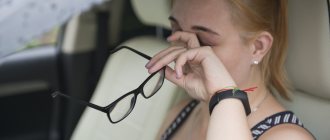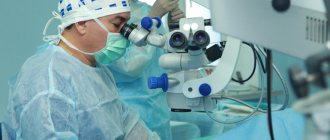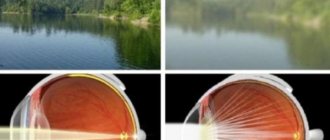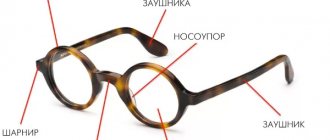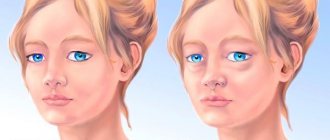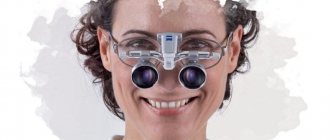A motorist who does not have diagnoses that limit the ability to see surrounding objects clearly enough will be able to obtain a vision certificate from an ophthalmologist for a driver’s license. During the medical examination, the motorist must obtain an examination by an ophthalmologist.
The specialist checks not only visual acuity, but also the correct perception of the color of objects and the angle of view. Citizens with 100% vision and those who are prescribed to wear glasses at all times will be granted permission without any restrictions.
Is it possible to get a license with poor eyesight?
If a person uses optical devices (glasses and lenses), then when planning to undergo a medical examination, you must take them with you. When assessing vision, the ophthalmologist will proceed from what a person sees with glasses that were previously prescribed to him. The specialist, based on the diagnostics performed, will decide whether the driver should change his glasses to improve visual perception or leave everything as it was. If the ophthalmologist notices a deterioration in vision after the test, he will write a prescription for glasses with different diopters. The bypass card will be signed only when the driver purchases new optics and demonstrates satisfactory visual acuity in them.
At the beginning of the test, the ophthalmologist will use a letter chart to check your visual acuity. Then he will move on to circles and ask you to say which of them does not close.
The doctor will enter all the examination data into the medical record, where he will indicate in a special box for notes whether the driver uses lenses (glasses) or does without them.
What is the visual acuity standard for obtaining a driver's license?
If the driver’s visual acuity is normal, then he is allowed to drive a vehicle according to the following principle:
- to category “B” (with limitation as - control is possible only if there is a steering wheel), while visual acuity in one eye is not lower than 0.6 units. and on the other not lower than 0.2 units;
- for category “C”, visual acuity in one eye is not lower than 0.8 units, in the other eye not lower than 0.4 units;
- to category “A”, “A1” or “B2”, where the steering wheel is of a motorcycle type, for one eye not less than 0.6 units, for the other not less than 0.2 units. In some cases, complete blindness in one eye is allowed if the visual acuity of the second eye does not fall below 0.8 units;
- if one eye is blind, then the vision of the second should be at least 0.8 units;
- in the event that both eyes of a person see equally poorly and there is no dominant one among them, then the permissible value of vision for driving is 0.7 units. for each eye.
When the question arises as to what kind of vision a driver’s license is not given, the answer is clear - if the visual acuity indicator is lower than that given in the standards when determining the category (these data are given above).
And to the question of what kind of vision you can get a license with, we will answer as follows - if, looking at the table, you see the 10th line, then there will be no problems with permission to drive. Otherwise, if there are problems with visual acuity, the specialist will take this into account and, taking into account the category, will build on this.
As for the power of the lenses, it should be no more than 8 diopters, while the difference in diopters between the visual acuity of the right and left eyes is no more than 3.
Is it possible to obtain admission from an ophthalmologist with poor vision?
Drivers who wear glasses or contact lenses must bring them with them to the medical examination. The doctor will take into account the results obtained without and with the ophthalmic device.
If it turns out that the previously prescribed glasses are no longer suitable, the specialist will recommend changing them to new ones.
When the patient does not see the required line of the checklist even with glasses, the doctor will refuse to sign the bypass sheet until a new check, for which the driver will have to appear in new optics.
Some motorists use a trick and come to their doctor's appointment wearing stronger glasses. This technique can play a cruel joke. The correction device causes discomfort, the eyes hurt and turn red. The ophthalmologist will definitely notice the discrepancy.
Visual acuity test
Visual acuity testing is mandatory. The examination is carried out taking into account corrections. All categories of driving have their own tolerances.
For people who wear glasses all the time, the difference between:
- lenses should be no more than 3 diopters:
- with two eyes without ophthalmological devices, up to 8 diopters are allowed between “–“ and “+”.
Color perception during vision testing
During an eye test, one of the important indicators is color perception, that is, how a person perceives light radiation. This is a kind of testing of the driver’s ability to distinguish the colors of a traffic light. For this purpose, a special Rabkin table is used.
Based on many years of research on this issue, scientists have identified 3 types of people, depending on their color sensitivity:
- The first type is trichromats (this is the absolute norm);
- The second type is protoanopes, when the disorder occurs in the red spectrum;
- The third type is deuteranope, when color perception in the green spectrum is impaired.
Any deviation from the norm is not very good, since in this case color perception cannot be corrected either with glasses or lenses.
Checking your horizons
Checking for this indicator is also an obstacle for some drivers when obtaining a license. If a person has a narrow horizon of vision, the value of which can be obtained through the study of the extreme narrowing of vision, then he may not be allowed to obtain a license. The narrowness of your horizons should not exceed 20 degrees.
Narrow vision also cannot be corrected with the help of optical means, so such a person cannot be allowed either to obtain a driving license or to drive a car.
Other eye diseases
Some eye diseases can also be an obstacle to obtaining a driving license. It all depends on the severity of these diseases. These include: retinal detachment, cataracts, glaucoma. In this case, all responsibility lies with the doctor, who must conduct a thorough check and give an appropriate conclusion about the driver’s suitability to drive a vehicle. Some drivers, in order not to lose their license, resort to all sorts of tricks, ranging from falsifying test results to purchasing a certificate certifying their “excellent” state of health. I would like to ask such drivers only one thing: if you do not value your life and get behind the wheel in such a state, then who will guarantee that other, innocent young people who are just entering this life will not suffer from your actions? given once?
If the driver has poor vision, the corresponding note in the medical card will indicate what type of transport he can be allowed to use using glasses or lenses.
What does the GCL mark on your license mean?
The GCL mark makes it clear to the inspector that the motorist has the right to drive only with vision-correcting devices (glasses, lenses). Such a citizen is prohibited from driving without ophthalmic devices.
Special marks are located on the back of the driver's document. In addition, the license may contain the entry “glasses are required” or “lenses are required. The clarified wording obliges the wearing of a certain type of correction devices while driving.
For motorists who alternately use glasses or lenses, the phrase “glasses or lenses are required” is included in the license.
What is the penalty for driving without glasses?
For people with vision problems, a mark is always placed on the driving license, which indicates that this driver without glasses (lenses) does not have the right to drive a vehicle. If he violates this regulation, he will face a fine. Its size in 2020 will be from 5 thousand rubles. — 15 thousand rubles.
paragraph 1 of Article 12.7 of Law No. 195-FZ “Code of the Russian Federation on Administrative Offences”
"1. Driving a vehicle by a driver who does not have the right to drive a vehicle (except for instructional driving) shall entail the imposition of an administrative fine in the amount of five thousand to fifteen thousand rubles.”
Driving without corrective vision aids is equivalent to driving without a license.
An interesting fact is that there is no article in the Legislation of the Russian Federation that would regulate driving without glasses. This is the only reason why driving without glasses, if there is a special mark on the driving license and requires them to be worn while driving, is a strict violation of the rules and leads to liability exactly the same as driving without a driving license.
Some drivers manage to avoid punishment, but only if they prove that they were just about to put on their glasses and were holding them in their hands, but the inspector’s signal to “stop” prevented them from doing so.
What contraindications are accepted for disabled people?
If you have certain established diseases, you can drive a car, but only with a certain type of vehicle or with the installation of additional devices that should compensate for their ailments. These are the following diseases:
— If the driver has foot deformities or both legs or both hips have been amputated. There are some diseases of the lower extremities - it is allowed to drive a car, but only with a manual transmission.
— If the upper limbs are missing (hands, fingers, etc.), or their deformation is present, these readings indicate the ability to drive a car with an automatic transmission
.
— If there is complete blindness in one eye, it will require the installation of an acoustic parking system.
— An obvious problem with hearing is the mandatory use of a hearing aid by the driver.
In addition to these diseases, there are also restrictions on driving certain types of vehicles (trucks, buses, etc.). For example, drivers who are less than one and a half meters tall cannot drive trucks.
Other diseases
The list of diseases with which you cannot obtain a driver's license contains the following items:
- congenital or acquired heart disease;
- heart surgery, if 3 months have not passed since it;
- difficulty breathing caused by diseases of the lungs, bronchi, larynx, trachea. For example, tuberculosis;
- some diseases of the spine;
- improperly healed after a bone fracture;
- deformation of the limbs, shortening of one limb by more than 6 cm with limitation of motor activity;
- some diseases of the endocrine system;
- retardation in physical development;
- absence of some phalanges of the fingers;
- defects of the skull bones with severe neuralgia;
- diseases of any origin that cause disorders of the vestibular apparatus;
- some hearing impairments.
In this case, a contraindication comes into force only if the listed diseases limit mental activity, motor activity, perception of the surrounding world, and the ability to make decisions in a difficult situation.
Ophthalmologist prohibits driving a car
It happens that at a given time the ophthalmologist does not have the right to give a positive opinion, and this may be in the following cases:
- Less than 3 months have passed since eye surgery;
- significant changes have occurred in the mucous membrane of the eyes or the muscles of the eyelid, which has led to deterioration of vision, but this can be restored surgically;
- there are problems with the lacrimal sac (the problem can also be eliminated with the help of surgery);
- sometimes strabismus causes diplopia of the eyes (split objects);
- if the driver has optic nerve atrophy or retinal detachment;
- glaucoma progresses.
What ophthalmological diseases will not allow you to get a license?
Citizens who have been diagnosed with:
- glaucoma (in later stages);
- retinal detachment;
- chronic and acute inflammation of the lacrimal sac;
- pathological changes in the optic nerve (death);
- double image of objects (diplopia);
- congenital and acquired pathologies of the eyelids, growths of the mucous membrane, creating an obstacle to normal vision.
In most cases, licenses can be issued after vision correction surgery has been performed. Rehabilitation processes and surgical intervention take 3 months or more. The medical commission will not give permission before this period. The patient comes to the examination with a correction device, if it was prescribed by a doctor.
It is not necessary to bring extracts from your medical history. To pass the examination, you need the final result of the treatment. The ophthalmologist will determine how much your vision has improved and decide whether to sign the permit.
Advice from ophthalmologists for obtaining a medical certificate for your license
Providing a medical report when obtaining a license is the responsibility of every driver, and it does not matter at all what category of license he receives.
The driver himself can sometimes feel changes in the functioning of the visual apparatus, which may manifest itself in a decrease in visual acuity or problems in color perception. In this case, the following recommendations will help:
- visit an ophthalmologist and get advice from this specialist. It’s not bad if the doctor specializes in the selection of corrective products for the eyes. Incorrectly selected optics may cause a refusal to issue a positive medical certificate for obtaining a licence. It must be remembered that each category has its own suitability indicators, so no one has ever managed to do without consulting an ophthalmologist;
- in some cases, the doctor advises the driver to undergo a course of vision stimulation (a special device is used for this). And if you observe your own body, you can understand that even throughout the day, visual acuity changes and this process is influenced by the state of the whole organism. For example, a day before visiting an ophthalmologist, you need to reduce physical activity, try not to get yourself emotional, and completely relax.
- Under no circumstances should you drink alcohol the day before or on the day of your doctor’s visit. This significantly worsens visual acuity.
Don’t despair if you don’t pass the medical examination the first time. Its results can always be appealed.
If you do not want to create a situation on the road in which the lives of many people will be endangered, undergo a medical check to be completely sure that your vision is in perfect order and will not fail you at a crucial moment.

